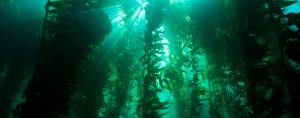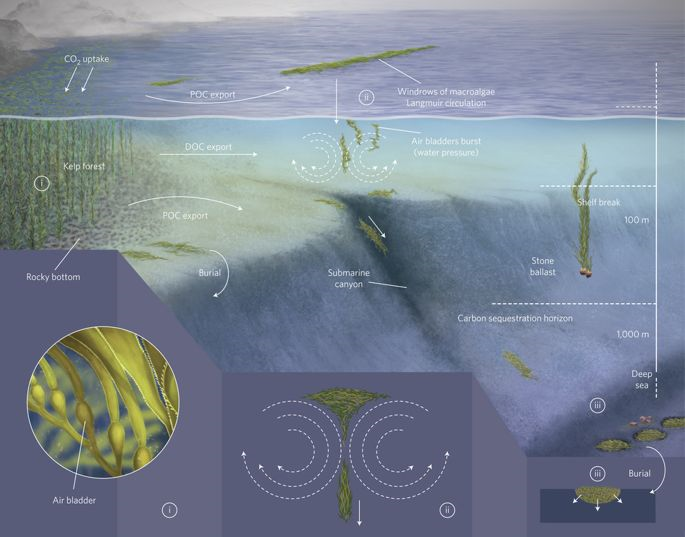Growing Carbon
 Seaweed, particularly Giant Kelp (Macrocystis pyrifera, which can grow up to half a metre per day, is an extremely efficient biological process for drawing carbon (CO2) from the air (via CO2 dissolved in the ocean). We are developing techniques for growing kelp on long lines below the ocean surface.
Seaweed, particularly Giant Kelp (Macrocystis pyrifera, which can grow up to half a metre per day, is an extremely efficient biological process for drawing carbon (CO2) from the air (via CO2 dissolved in the ocean). We are developing techniques for growing kelp on long lines below the ocean surface.
These lines will provide a substrate (something the kelp can hang onto) in water which would be too deep for the kelp to grow naturally. Macrocystis pyrifera (Giant Kelp) grows to lengths of 20-30 metres and has a net primary production (NPP) in natural forests of around 5.2 kg dry matter/m2/year (Rassweiler, 2018) (5.25 kg CO2 equiv./m2/year)[1] compared to an average of around 0.95 kg dry matter/m2/year (1.74 kg CO2equiv./m2/year) for temperate radiata pine forest plantations. Giant kelp draws down upon atmospheric carbon 3 times faster per unit area than the fastest growing trees (eg. pine trees).
Sinking Carbon
 Carbon moves continuously through different states (the carbon cycle). Through photosynthesis it is taken from the air in the form of CO2 and is locked up in organic matter (carbohydrates). When these plants lose leaves and branches, or die, this carbon is broken down by microbes and released into the air again as CO2. Therefore, plants can only temporarily lock carbon away from the air (where it is causing climate change). However, here's the kicker, with marine carbon such as kelp.
Carbon moves continuously through different states (the carbon cycle). Through photosynthesis it is taken from the air in the form of CO2 and is locked up in organic matter (carbohydrates). When these plants lose leaves and branches, or die, this carbon is broken down by microbes and released into the air again as CO2. Therefore, plants can only temporarily lock carbon away from the air (where it is causing climate change). However, here's the kicker, with marine carbon such as kelp.
A significant amount of the vast amounts of debris coming off this kelp finds its way to very deep water where, due to the extreme pressure, darkness, cold and lack of oxygen this carbon does not get readily broken down and returned to the air. Consequently, unlike land-based organic carbon, this dead marine organic matter that reaches depths of more than 1 km, becomes near permanently locked away from the atmosphere.
The Scale of the Investment
 So how much kelp would we need to offset current global CO2 emissions? This is where we are faced with the awesome scale of the problem, 37.1 billion tons of CO2 being emitted by human activity in 2018. Tim Flannery has estimated we would need to cover 9% of the world's oceans (about 33,000,000 km² or 3.3 times the surface area of the USA).
So how much kelp would we need to offset current global CO2 emissions? This is where we are faced with the awesome scale of the problem, 37.1 billion tons of CO2 being emitted by human activity in 2018. Tim Flannery has estimated we would need to cover 9% of the world's oceans (about 33,000,000 km² or 3.3 times the surface area of the USA).
While kelp farming cannot offset these emissions alone, this is no place for the faint hearted - we need to get our flippers on. The Exclusive Economic Zone of New Zealand is about 4,300,000 km² but the coastal belt of water less than 200 m deep (where screw peer anchored kelp farms can be built) is only about 150,000 km². The next generation of kelp farms are likely to be mobile structures carried through the water by drones.
To attract the massive investment required we will need to identify opportunities for these farms to be profitable through the production of valuable human and animal food products, pharmaceuticals, nutriceuticals, biofuels and carbon credits. This investment must come from motivated ethical investors, but equally importantly, the millions of people across the globe who wish to have a role in combating climate change.
Macrocystis Deep Water Sequestration

The Process of Sequestration of Macrocystis Kelp Detritis (Bayley, Marengo, Baker, & Pelembe, 2017)
Our Skills & Expertise
Lorem ipsum dolor sit amet, semper cetero iisque in usu. Sit vocent fuisset consequat ei, at wisi possim sea, utamur lobortis torquatos id sit. Has te bonorum consequat, at dicunt placerat eam, vocibus necessitatibus ei eos. Sea malorum forensibus ne, an mea habeo option copiosae, congue labores eu qui. Illud principes ne vix, vide novum consequuntur vim cu, mea ad tincidunt pertinacia consetetur. Eu nostro detraxit signiferumque pri, ne dolor vidisse eum, principes intellegebat est eu. Dolorem deterruisset ad nam, cum saepe aperiri an, ne sit modo urbanitas vulputate.